The constellations best seen in August are Aquila, Corona Australis, Lyra, Pavo, Sagitta, Sagittarius, Scutum and Telescopium. Lyra, Sagitta and Aquila are northern constellations and Scutum, Sagittarius, Corona Australis, Telescopium and Pavo are located in the southern sky.
August is the best time of year to observe a number of prominent deep sky objects located in these constellations. The best known ones include the Ring Nebula (Messier 57), the Glowing Eye Nebula (NGC 6751), the Wild Duck Cluster (Messier 11), the Lagoon Nebula (Messier 8), the Omega Nebula (Messier 17), the Trifid Nebula (Messier 20), the Sagittarius Star Cloud (Messier 24) and the Condor Galaxy (NGC 6872).
Lyra, the northernmost of the August constellations, is relatively small, occupying an area of 286 square degrees. It is easy to find because its brightest star, Vega (Alpha Lyrae), is the fifth brightest star in the sky and the second brightest star in the northern sky, slightly dimmer only than Arcturus. Vega is a white main sequence star with a visual magnitude of 0.026, located at a distance of only 25.04 light years from Earth. It is 40 times more luminous than the Sun. It is classified as a Delta Scuti variable, which means that it exhibits variations in luminosity as a result of radial and non-radial pulsations of its surface.
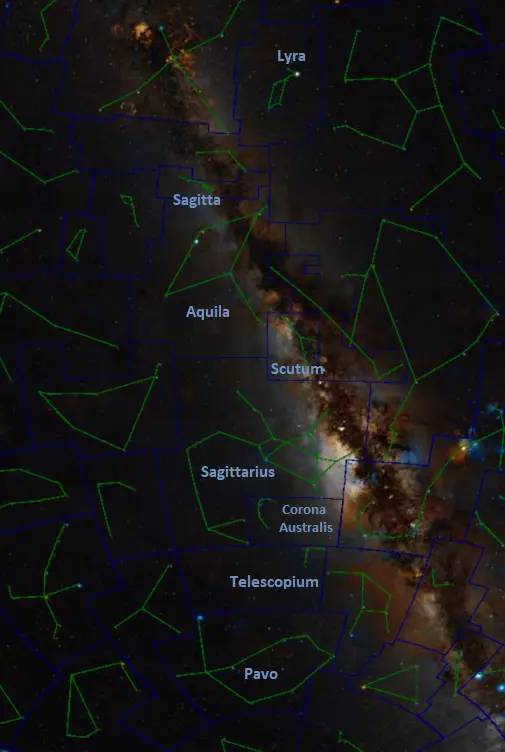
August constellations, image: Wikisky
Lyra is home to several other famous variable stars. These include Beta Lyrae and RR Lyrae. Beta Lyrae, which serves as a prototype of the Beta Lyrae variables, is a close binary system that exhibits changes in brightness because the two components orbit each other and periodically block each other’s light. The eclipsing stars are so close that mass flows from one to the other and they are distorted by gravitational forces into an ellipsoidal shape. RR Lyrae is the prototype of the RR Lyrae variables, evolved giant stars that pulsate over a period of 0.2 to 1 day. These stars are commonly found in globular clusters and are used as standard candles to measure distance.
Lyra contains two Messier objects: the famous Ring Nebula (M57) and the globular cluster Messier 56. The Ring Nebula is a planetary nebula with an apparent magnitude 8.8, located south of Vega. It can be seen in a small telescope, but is best observed in larger instruments. It is one of only four planetary nebulae included in Messier’s catalogue. Messier 56 has an apparent magnitude of 8.3 and is found halfway between Sulafat, Gamma Lyrae, which sits opposite to Vega, and the famous double star Albireo, Beta Cygni, located at the base of the Northern Cross in Cygnus.
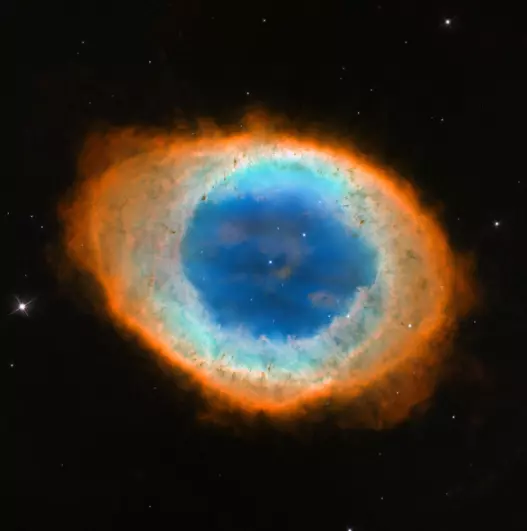
This image shows the dramatic shape and colour of the Ring Nebula, otherwise known as Messier 57. From Earth’s perspective, the nebula looks like a simple elliptical shape with a shaggy boundary. However, new observations combining existing ground-based data with new NASA/ESA Hubble Space Telescope data show that the nebula is shaped like a distorted doughnut. This doughnut has a rugby-ball-shaped region of lower-density material slotted into in its central “gap”, stretching towards and away from us. Image: NASA, ESA, and C. Robert O’Dell (Vanderbilt University)
Other notable deep sky objects in the constellation include the irregular galaxy NGC 6745, consisting of a trio of galaxies that are in the process of merging, and the globular cluster NGC 6791, one of the oldest clusters in our galaxy.
Vega is part of the Summer Triangle, a large asterism that dominates the evening sky in the summer months. The other two stars that form the vertices of the triangle are Deneb and Altair, the brightest stars in the constellations Cygnus and Aquila.
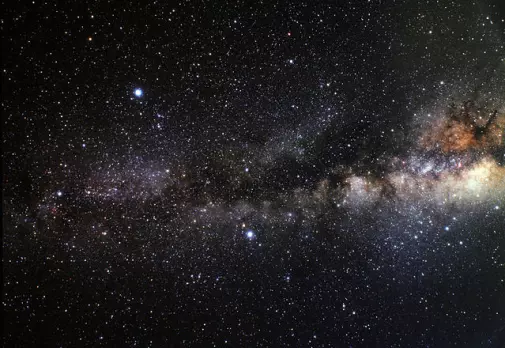
The Summer Triangle, image: NASA, ESA. credit: A. Fujii
Altair, Alpha Aquilae, is the 12th brightest star in the sky, with a visual magnitude of 0.76. Located at a distance of only 16.73 light years from Earth, the white dwarf is one of the nearest stars visible to the unaided eye. The two relatively bright stars on either side of Altair are Tarazed, Gamma Aquilae, the second brightest star in Aquila (mag. 2.7), and Alshain, Beta Aquilae, the constellation’s seventh brightest star (mag. 3.71). Tarazed is an orange bright giant and Alshain is a binary star system composed of a yellow subgiant and a faint red dwarf.
Aquila contains several notable deep sky objects. The Glowing Eye Nebula (NGC 6751) is a planetary nebula made famous when its image was chosen to commemorate the Hubble’s 10th anniversary. The Phantom Streak Nebula (NGC 6741) and NGC 6781 are two other planetary nebulae in the constellation. Aquila is also home to the open clusters NGC 6709 (mag. 6.7) and NGC 6755 (mag. 7.5), and to the globular cluster NGC 6760 (mag. 9.0).
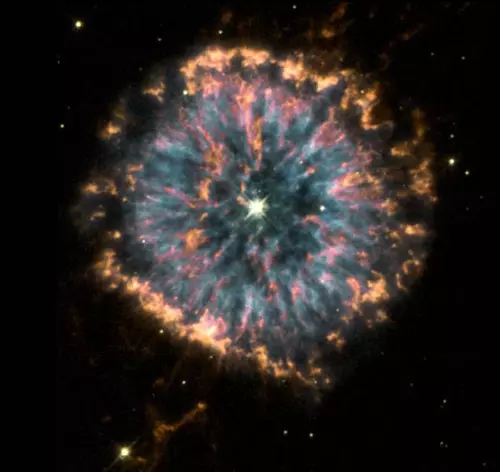
The Glowing Eye Nebula (NGC 6751), image: NASA, The Hubble Heritage Team (STScI/AURA)
Sagitta is a small and faint constellation, but its distinctive shape of an arrow makes it easy to identify in good conditions. It is the third smallest constellation in the sky, occupying an area of only 80 square degrees, and it does not have any stars brighter than 3rd magnitude. Its brightest star, Gamma Sagittae, marks the arrow’s head.
Sagitta is home to two interesting deep sky objects. The loosely concentrated globular cluster Messier 71 has a visual magnitude of 6.1. It was believed to be an open cluster until the 1970s. The Necklace Nebula (PN G054.2-03.4) is a planetary nebula spanning 2 light years, located at a distance of 15,000 light years.
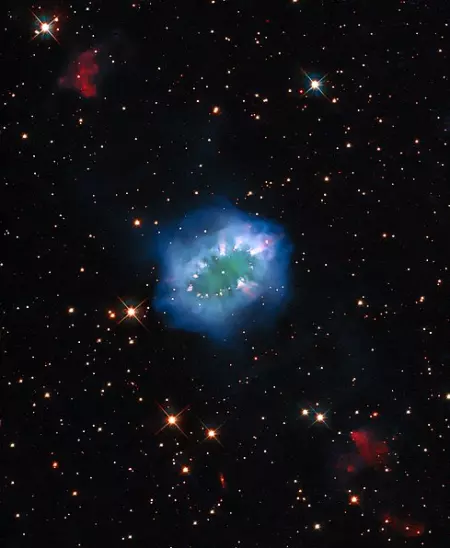
The interaction of two doomed stars has created this spectacular ring adorned with bright clumps of gas — a diamond necklace of cosmic proportions. Fittingly known as the Necklace Nebula, this planetary nebula is located 15 000 light-years away from Earth in the small, dim constellation of Sagitta (The Arrow). The Necklace Nebula — which also goes by the less glamorous name of PN G054.2-03.4 — was produced by a pair of tightly orbiting Sun-like stars. Roughly 10 000 years ago, one of the aging stars expanded and engulfed its smaller companion, creating something astronomers call a “common envelope”. The smaller star continued to orbit inside its larger companion, increasing the bloated giant’s rotation rate until large parts of it spun outwards into space. This escaping ring of debris formed the Necklace Nebula, with particularly dense clumps of gas forming the bright “diamonds” around the ring. The pair of stars which created the Necklace Nebula remain so close together — separated by only a few million kilometres — that they appear as a single bright dot in the centre of this image. Despite their close encounter the stars are still furiously whirling around each other, completing an orbit in just over a day. Image: ESA/Hubble & NASA, K. Noll
Scutum, representing the shield, is also among the smallest constellations. With an area of 109 square degrees, it is the 84th constellation in size. Its stars are quite faint. The brightest one, the orange giant Alpha Scuti, has an apparent magnitude of 3.83. Other stars in the constellation are fainter than magnitude 4.00.
Scutum contains the famous variable star Delta Scuti. With a visual magnitude of 4.72, it is the fifth brightest star in the constellation. It is a white giant that serves as a prototype for a class of variable stars known as the Delta Scuti variables or dwarf Cepheids. Like RR Lyrae stars, Delta Scuti stars are pulsating variables, but they are smaller, fainter and have shorter pulsation periods.
Scutum is home to two bright open star clusters, the Wild Duck Cluster (Messier 11) and Messier 26. The Wild Duck Cluster has an apparent magnitude of 5.8. It was named for its resemblance to a flying flock of ducks. It is one of the most compact open clusters known, as well as one of the richest and most massive. Messier 26 is considerably fainter at magnitude 8.0. It lies in the same area as M11.
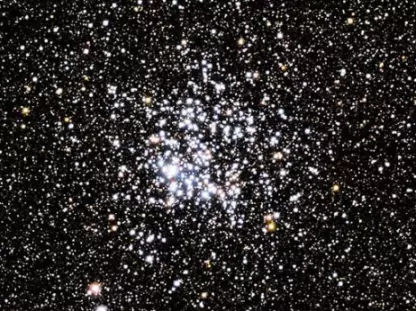
The open cluster Messier 11 – Many stars like our Sun were formed in open clusters. The above pictured open cluster, M11, contains thousands of stars and is just over five thousand light years distant. The stars in this cluster all formed together about 250 million years ago. The bright young stars in M11 appear blue. Open clusters, also called galactic clusters, contain fewer and younger stars than globular clusters. Also unlike globular clusters, open clusters are generally confined to the plane of our Galaxy. M11 is visible with binoculars towards the constellation of Scutum. Image: NASA
Other notable deep sky objects in Scutum include the magnitude 8.69 globular cluster NGC 6712 and the planetary nebula IC 1295.
Sagittarius is the 15th largest constellation in the sky, with an area of 867 square degrees, and one of the most prominent southern constellations. It has seven stars brighter than magnitude 3.0. The brightest star in the constellation is the blue giant Kaus Australis (Epsilon Sagittarii), with a visual magnitude of 1.85.
With an asterism known as the Teapot dominating much of the constellation, Sagittarius and its many famous deep sky objects are very easy to find. The Teapot is formed by the constellation’s eight brightest stars.
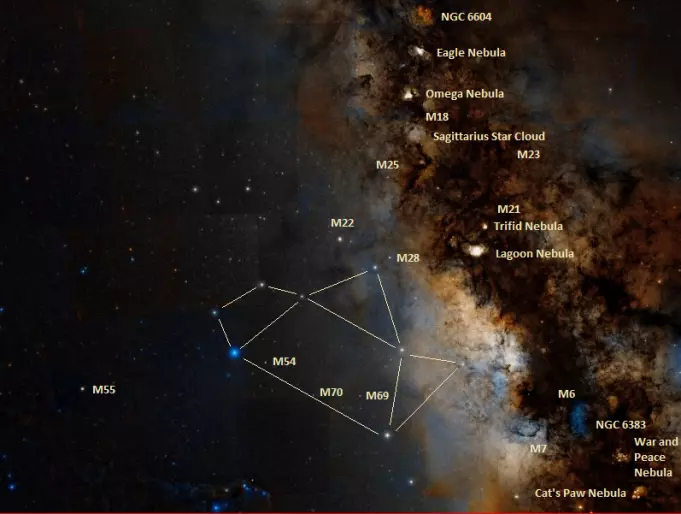
Deep sky objects near the Teapot. Image: Wikisky
Sagittarius has 15 Messier objects within its borders, more than any other constellation. They are the emission nebulae Messier 8 (Lagoon Nebula) and Messier 17 (Omega Nebula), the emission, reflection and dark nebula Messier 20 (Trifid Nebula), the globular clusters Messier 22, Messier 28, Messier 54 (extragalactic cluster), Messier 55, Messier 69, Messier 70 and Messier 75, the open clusters Messier 18, Messier 21, Messier 23 and Messier 25, and the Sagittarius Star Cloud (Messier 24), a large Milky Way star cloud that consists of the densest concentration of individual stars that can be observed in binoculars.
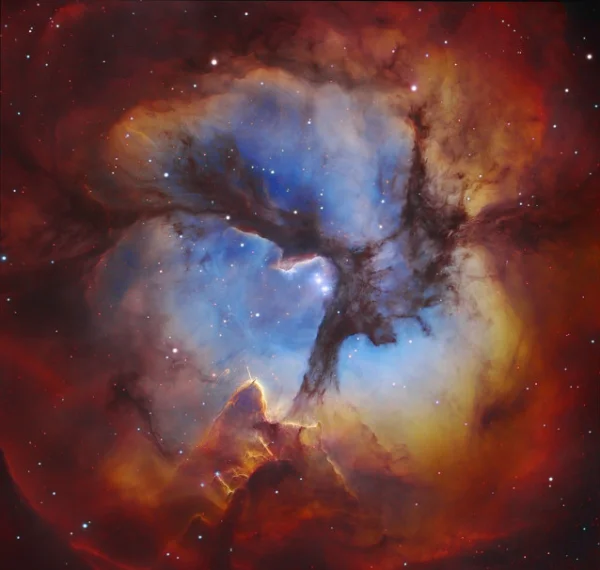
The central region of the Trifid Nebula (M20). Image: Subaru Telescope (NAOJ), Hubble Space Telescope, Martin Pugh; Processing: Robert Gendler
Sagittarius also contains two of the most luminous stars known, the Pistol Star and the Peony Star. The Pistol Star is a blue hypergiant 1.6 million times more luminous than the Sun. It illuminates the Pistol Nebula. The Peony Star (WR 102ka) is a Wolf-Rayet star with an estimated luminosity 3.2 million times that of the Sun.
The centre of the Milky Way is located in Sagittarius. The compact radio source Sagittarius A* is the top candidate for the location of the supermassive black hole at the centre of the galaxy. The Galactic Centre lies in one of the brightest patches of the Milky Way, near an area known as Baade’s Window, which has relatively little interstellar dust and offers a view of the central bulge stars. The window covers about a degree of the sky and is centered on the globular cluster NGC 6552.
Other prominent deep sky objects in Sagittarius include the planetary nebulae NGC 6537 (Red Spider Nebula), NGC 6565, the Little Gem Nebula (NGC 6818), NGC 6445, M 1-42 (Eye of Sauron Nebula, ESO 456-67) and NGC 6578, the Arches Cluster, the densest open cluster discovered in our galaxy, the Quintuplet Cluster, another dense open cluster and home to the Pistol Star, the globular clusters NGC 6522 and NGC 6528, and Barnard’s Galaxy, a barred irregular galaxy in the Local Group.
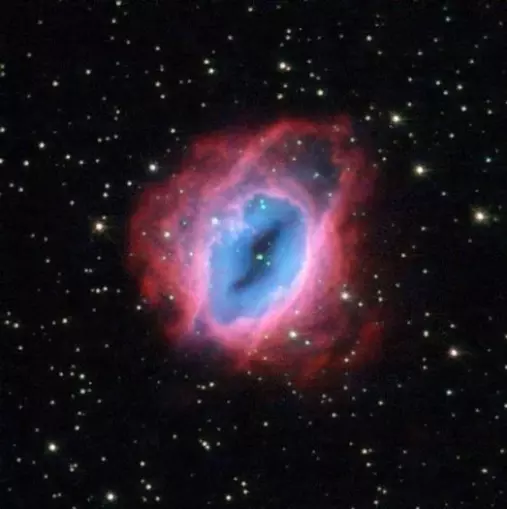
It may look like something from “The Lord of the Rings,” but this fiery swirl is actually a planetary nebula known as ESO 456-67. Set against a backdrop of bright stars, the rust-colored object lies in the constellation of Sagittarius (The Archer), in the southern sky. In this image of ESO 456-67, it is possible to see the various layers of material expelled by the central star. Each appears in a different hue – red, orange, yellow, and green-tinted bands of gas are visible, with clear patches of space at the heart of the nebula. It is not fully understood how planetary nebulae form such a wide variety of shapes and structures; some appear to be spherical, some elliptical, others shoot material in waves from their polar regions, some look like hourglasses or figures of eight, and others resemble large, messy stellar explosions – to name but a few. Image: ESA/Hubble and NASA
Corona Australis, the Southern Crown, is the 80th constellation in size, with an area of 128 square degrees. The constellation’s oval-shaped pattern is easy to identify on a clear night from dark locations, but not from areas with too much light pollution. Located between the brighter Sagittarius and Scorpius, Corona Australis is considerably fainter than its northern counterpart, Corona Borealis, with no stars brighter than magnitude 4.0. The brightest star in the constellation, Beta Coronae Australis, is an orange bright giant with a visual magnitude of 4.1.
Corona Australis is home to the Corona Australis Molecular Cloud, one of the nearest star-forming regions to Earth. The cloud lies at a distance of 430 light years. The region is a mix of bright and dark nebulae. The variable stars R and T Coronae Australis illuminate portions of the cloud and, as a result of their variability, its brightness also changes. The cloud contains a number of reflection nebulae, including NGC 6729 (illuminated by R Coronae Australis), IC 4812 and NGC 6726/6727. The Coronet Cluster, a small open cluster embedded within the cloud, has an apparent magnitude of 8. It lies in the centre of the constellation.
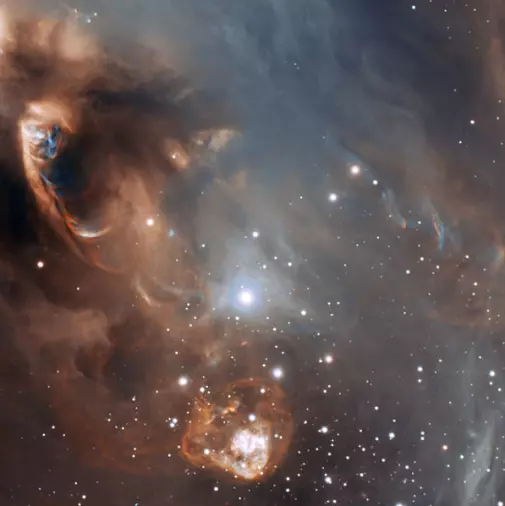
This very detailed false-colour image from ESO’s Very Large Telescope shows the dramatic effects of very young stars on the dust and gas from which they were born in the star-forming region NGC 6729. The baby stars are invisible in this picture, being hidden behind dust clouds at the upper left of the picture, but material they are ejecting is crashing into the surroundings at speeds of that can be as high as one million kilometres per hour. This picture was taken by the FORS1 instrument and records the scene in the light of glowing hydrogen and sulphur. Image: ESO
South of Corona Australis, Telescopium is another faint constellation, with no stars brighter than magnitude 3.0. Telescopium does not have many bright deep sky objects either. It is home to the Telescopium Group, a group of 12 galaxies 120 million light years away. The brightest members are the elliptical galaxy NGC 6868 and spiral or lenticular galaxy NGC 6861. Other notable deep sky objects in Telescopium include NGC 6845, a group of four interacting galaxies, the globular cluster NGC 6584, the magnitude 11.3 elliptical galaxy IC 4889 and the planetary nebula IC 4699.
Pavo, the Peacock, is one of the constellations known as the “Southern Birds,” along with Phoenix, Tucana (the Toucan) and Grus (the Crane). Its brightest star, Alpha Pavonis, is also named Peacock. It is a spectroscopic binary star system with a visual magnitude of 1.94. The constellation’s second brightest star, Beta Pavonis, is considerably fainter. It is a white giant with an apparent magnitude of 3.42.
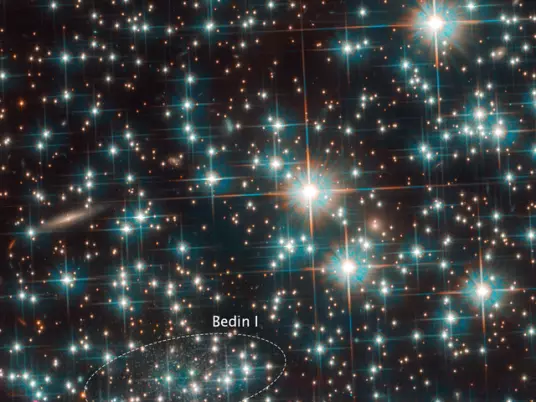
This is a Hubble Space Telescope image of a concentration of stars within the globular cluster NGC 6752. Hidden among the stars is an image of a background galaxy that is much farther away. The diminutive galaxy, named by its discoverers as Bedin 1, measures only around 3,000 light-years at its greatest extent — a fraction of the size of the Milky Way. Not only is it tiny, but it is also incredibly faint. These properties led astronomers to classify it as a dwarf spheroidal galaxy that is as old as the universe. Image: NASA, ESA, and L. Bedin (Astronomical Observatory of Padua, Italy)
Pavo is home to NGC 6752, the third brightest globular cluster in the sky. With a visual magnitude of 5.4, it is only fainter than Omega Centauri in Centaurus and 47 Tucanae in Tucana. Other interesting deep sky objects in the constellation include the spiral galaxy NGC 6744 (mag. 9.14), the interacting galaxies NGC 6872 (Condor Galaxy, one of the largest spiral galaxies known) and IC 4970 (mag. 12.7 and 14.7), and the triplet of colliding galaxies designated as IC 4686, IC 4687 and IC 4689.
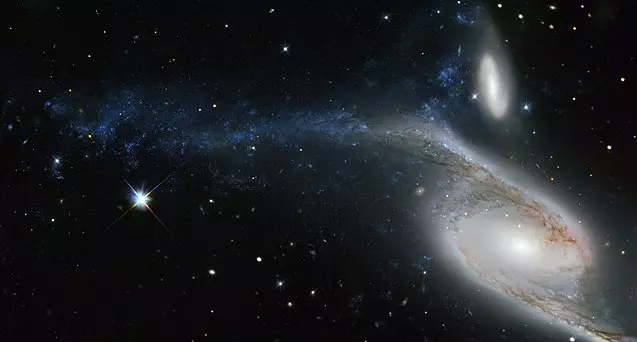
This picture, taken by the NASA/ESA Hubble Space Telescope’s Wide Field Planetary Camera 2 (WFPC2), shows a galaxy known as NGC 6872 in the constellation of Pavo (The Peacock). Its unusual shape is caused by its interactions with the smaller galaxy that can be seen just above NGC 6872, called IC 4970. They both lie roughly 300 million light-years away from Earth. Image: ESA/Hubble & NASA, acknowledgement: Judy Schmidt
The table below shows the latitudes between which the constellations are visible.
| Constellation | Northern latitude | Southern latitude |
| Aquila | 90° | 75° |
| Corona Australis | 40° | 90° |
| Lyra | 90° | 40° |
| Pavo | 30° | 90° |
| Sagitta | 90° | 70° |
| Sagittarius | 55° | 90° |
| Scutum | 80° | 90° |
| Telescopium | 40° | 90° |